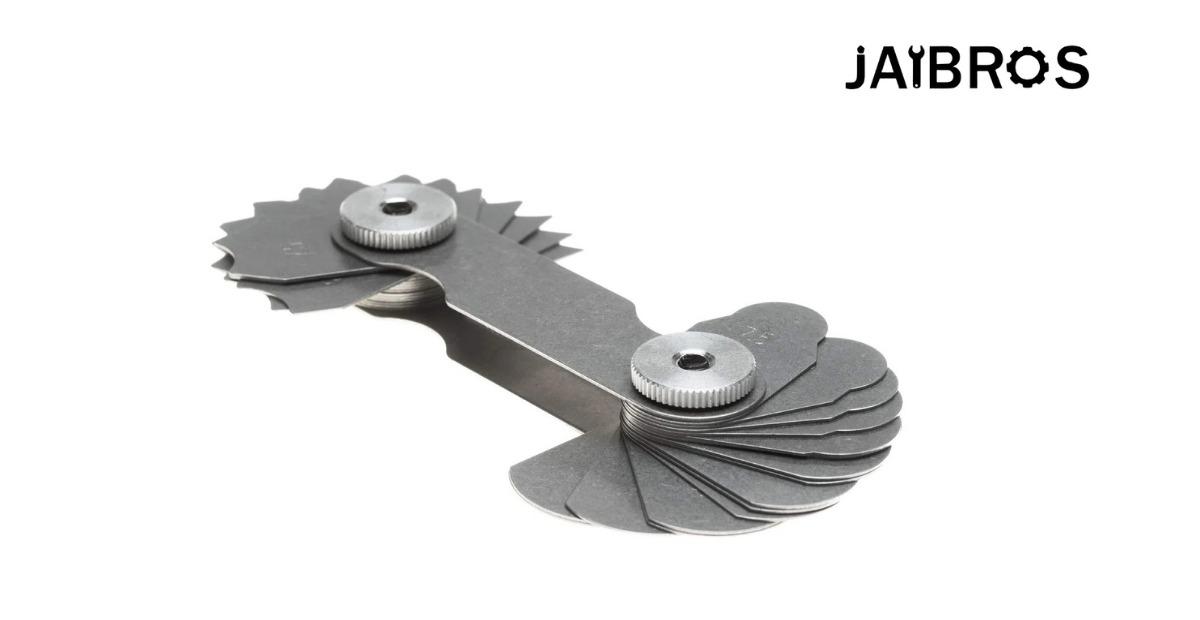Radius Gauge: Complete Guide, Uses, Types & Benefits

Everything You Need to Know About Radius Gauge Tools
In machining, fabrication, and quality inspection, accuracy is paramount. When working with curved profiles, rounded components, or accurately machined edges, professionals will rely on a tool specifically designed to measure radii with confidence—the radius gauge. Whether you're in a CNC workshop, automotive environment, toolroom, or mechanical engineering environment, this tool easily helps you confirm that each curve adheres to specified dimensions. This guide will help teach you everything you need to know about features, types, applications and the overall buying process so you can choose the best gauge available for your needs.
What Is a Radius Gauge?
A radius gauge is a measuring instrument that gives a precise measurement of a curved radius. The gauge typically has a series of blades, each with a specific radius to allow the user to match the curve of the part. A radius gauge is commonly used to ensure that the workpiece has conformed to the specified design and specifications, especially in industries that must use standardized round corners for functional, safety, or aesthetic reasons.
A common set of gauges has multiple gauges that have a concave and convex profile, which makes it suitable to measure a variety of components. Gauge sets are commonly used in metalworking, woodworking, pattern making, and mechanical part measurement inspection.
Why Gauges Are Essential in Industrial Work
Curves and rounded edges are present in almost every industry—from automotive components to machine parts, tools, dies, molds, and architectural fittings. A gauge helps ensure:
-
Consistency in curved shapes
-
No deviation from design tolerances
-
Smoothness and accuracy of edges
-
Quality control during production
-
Faster inspection compared to manual methods
With industries pushing for tighter tolerances, the value of a reliable gauge continues to increase.
Gauge Range Assessment
One important consideration in selecting your gauge is investigating gauge range. Different sets provide you with different radius ranges, according to your application. Workshops that work on smaller tools or intricacies tend to select gauge sets with a finer-ranging range, from 0.5 mm to 7 mm, while industries dealing with larger components will find gauge sets with ranges up to 25 mm or greater.
Selecting a gauge range is important because you do not want to invest in additional measurements you do not need and possibly overlook a very important size.
Types of Radius Gauge Sets and Their Uses
A radius gauge set can be categorized based on type, material, and design. Here are the most common types:
1. Standard Radius Gauge Set
Includes multiple blades covering a fixed radius range. Used for general-purpose measurements.
2. Internal and External Gauges
Some sets include separate blades for internal curves (concave surfaces) and external curves (convex surfaces).
3. Adjustable Gauges
Allow users to measure custom radii not found in fixed sets. Useful for prototyping and R&D tasks.
4. Stainless Steel Radius Gauges
These are durable, corrosion-resistant, and ideal for industrial environments.
5. Metric and Inch Radius Gauge Sets
Depending on the industry, you may require metric, imperial, or dual-scale measurements.
Each gauge set serves different professional needs, so choosing the right one saves time and increases measurement accuracy.
How to Use a Gauge Correctly
Using a gauge is simple but requires precision:
-
Clean the part to remove dust or burrs.
-
Select the blade closest to your required radius.
-
Match the blade curve with the component.
-
Check for gaps between the blade and the surface.
-
Repeat with adjacent blade sizes until you find a perfect fit.
A correct fit means no light passes between the blade and the surface. This method is widely used in tool inspection, finishing work, and process validation.
Factors That Affect Radius Gauge Price
The gauge price depends on several factors:
-
Material quality (stainless steel costs more but lasts longer)
-
Number of blades included
-
Brand reputation
-
Accuracy and finishing quality
-
Metric, imperial, or dual system
High-precision, industrial-grade sets naturally come at a higher gauge price, but they offer longer life and consistent accuracy—making them worth the investment for professional workshops.
Common Industrial Applications of a Radius Gauge
Here’s where a gauge is used most:
-
CNC machining
-
Die and mold making
-
Automotive part inspection
-
Aerospace component finishing
-
Mechanical engineering
-
Sheet metal fabrication
-
Woodworking and furniture design
-
Quality control departments
Wherever there is a curve to measure, a gauge is essential.
Buying Guide: How to Choose the Best Radius Gauge
When choosing a gauge, consider the following:
-
Required radius gauge range based on your work
-
Size and number of blades in the radius gauge set
-
Material durability
-
Clarity of radius markings
-
Accuracy and ease of use
-
Brand and customer reviews
-
Radius gauge price compared to build quality
Buying the right tool ensures smooth inspection processes and better finishing results.
Conclusion:
If you require reliable measuring instruments engineered for accuracy within industrial processes, you can be assured that Jaibros is a trustworthy company that produces and sells long-lasting, high-precision products. Jairobs’ product line includes high-quality radius gauges used by engineers, machinists, and inspectors. Jaibros offers competitively priced tools with accuracy ratings and a broad selection of essential tools for the workshop that can be trusted for quality assurance.
FAQs
1. What is a radius gauge used for?
It is used to measure and verify the radius of curved surfaces or edges.
2. What is included in a radius gauge set?
A set usually includes multiple concave and convex blades for different radius measurements.
3. How do I choose the right radius gauge range?
Select a range based on the smallest and largest radii you frequently measure.
4. What affects the radius gauge price?
Material, number of blades, accuracy, and brand reputation affect pricing.
5. Is a radius gauge suitable for CNC machining work?
Yes, it is widely used to verify curved edges, tool profiles, and machined radii.






